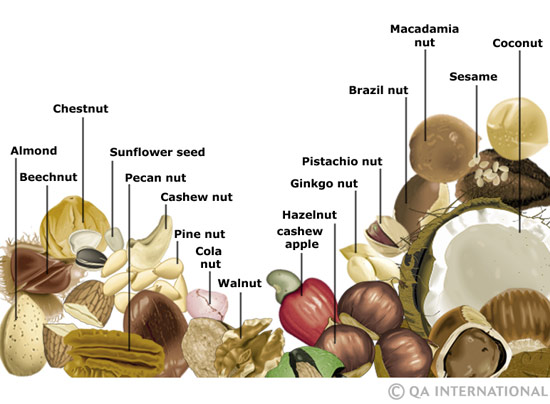Nuts and seeds
The term “nut” is applied to various fruits having a hard outer shell enclosing a kernel (also called a nut), while “seeds” are contained in the fruits of plants and are capable of producing a new plant when released from the fleshy part of the fruit. Nuts and seeds have been used as food by humans for thousands of years; they were an essential part of the diet for primitive hunter-gatherer cultures and are also a source of nourishment for many animal species. Pistachios, walnuts, and almonds were already under cultivation in biblical times in Southeast Asia and were held in high esteem by the ancient Greeks and Romans.
The most commercially important varieties of nuts produced in the world today are the coconut, almond, walnut, hazelnut, chestnut, cashew, and pistachio. Nuts and seeds continue to be a popular food, for they are highly nutritious and require little preparation.

Buying nuts and seeds
The market offers nuts and seeds in many different forms: they are available with or without their shell, whole, halved, cut in fine slices or slivers, chopped, ground, plain, roasted, with or without their brown skin, salted, smoked, sweetened, or coated in candy or chocolate. They are also processed to make butter, oil, and sweetened or unsweetened spreads. The shells of nuts provide a protective coating that prevents the nuts from turning rancid as quickly. When purchasing unshelled nuts, choose those with undamaged shells.
When buying shelled nuts, it is best to buy those sold in vacuum-sealed glass jars, in cans, or in sealed bags, all of which ensure maximum freshness. It is also a good idea to buy nuts in stores with a rapid turnover.
Serving ideas
Nuts and seeds have a wide array of culinary and decorative uses. They go just as well with savory dishes as with sweet dishes, and they make an ideal snack or appetizer. They are also a good complement to or replacement for meat. Nuts sold with their skin have a stronger flavor than skinned nuts. A number of savory oils are extracted from nuts and seeds, which are also processed to make butter and flour.
Storing nuts and seeds
Nuts sold in the shell tend to keep better than shelled, cut, chopped, or ground nuts. They should be stored in an airtight container away from direct light, heat, and moisture. Depending on the variety, nuts will keep for 2 to 9 months in the refrigerator.
Unshelled nuts freeze well and will keep for about a year in the freezer. Shelled, cut, chopped, or ground nuts and seeds should be stored at room temperature in an airtight container or package. Once the package has been opened, transfer the nuts to a sealed container and keep them in a cool, dry, dark place for short-term storage or in the refrigerator or freezer for longer storage.
Nutritional Information
Nuts and seeds are high in fat and calories. While their nutritional value varies widely, in general nuts contain from 3 to 10 grams of protein, 17 to 37 grams of fat, and 8 to 16 grams of carbohydrates. Two exceptions are the ginkgo, which contains only 1.1 grams of fat while containing 37 grams of carbohydrates, and 175 to 355 calories per 50 grams; and the chestnut, with 0.6 gram of fat, 22 grams of carbohydrates, and 98 calories per 50 grams.
The fat in nuts is mainly in the form of monounsaturated and polyunsaturated fatty acids, with the exception of the coconut, which contains mainly saturated fatty acids (see Fats). Since they are of plant origin, nuts and seeds do not contain cholesterol. While all nuts are a source of dietary fiber, Brazil nuts and sunflower seeds are particularly high in fiber. Because of their high fat and calorie content, and because they are often salted, it is best to consume nuts and seeds in moderate quantities. They are also easier to digest when chewed thoroughly or when finely ground. Most nuts and seeds are excellent sources of magnesium, copper, and potassium; they are also a good source of thiamine and folic acid, and usually contain iron, pantothenic acid, and riboflavin.




